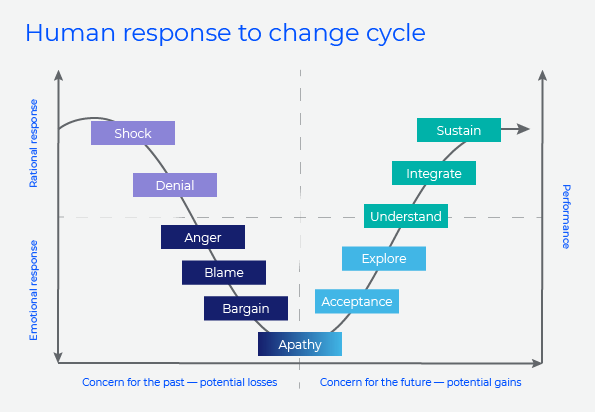

When guiding teams through significant organizational change, a common first step is to assess employee readiness for change. The COVID-19 pandemic however blindsided most businesses, leaving teams completely unprepared. Rather, teams have been forced to adapt and develop new habits, goals and systems in a very rapid way.
As suggested in my previous post “Leading Through Chaos”, it is important to have an active Communications Plan to guide your team through the coming weeks and months. In my Executive Coaching practice, I find that teams are now in the midst of a very difficult period known as the “valley of despair”, marked by struggles with motivation and apathy.
Good leadership during crises is the ability to reframe the crises for your team. Elizabeth Kubler-Ross’s five stages of grief (Denial, Anger, Bargaining, Depression, Acceptance) is a helpful tool for employees to make sense of and keep perspective on what they are feeling as they adjust to massive change.

Good leadership during crises is also the ability to usher your teams through these stages, minimizing performance fallouts, maintaining employee engagement, and being able to adapt to shifting information and circumstances.
You may notice that individuals on your team, even in senior level leadership positions, may be stalled in earlier stages of this process. Below are examples of how to tailor your communications to address the common challenges at each stage.
a. Shock/Denial. Employees may deny the facts about COVID-19, trying to minimize its lethal impact (e.g. comparing it to the flu). We see this playing out in a disturbing way in Brazil, whose President Jair Bolsonaro has denied the seriousness of coronavirus, rejecting the advice of health officials and denying scientific evidence. Although this is an extreme example, employees in denial must be gently challenged out of states of denial and made to understand the very real risks of such denial. This can be done primarily through continuous education and raising their awareness of the facts.
b. Anger/Blame. Employees who want to blame others–whether Florida spring breakers or religious leaders refusing to end mass gatherings or 5G technology–can end up bringing a negative attitude (and faulty thinking) to other team members, vendors and customers. It is important to let employees know that broadcasting their personal beliefs about who is to blame for COVID-19 is not constructive or appropriate in the workplace. Validating employee frustration and anger is helpful, while reminding them of the importance of focusing on what they can personally do that is constructive and helpful, not what others didn’t do.
c. Apathy. This can be reflected in low drive, motivation and poor performance. The realities of COVID-19 including the challenges of quarantine life, the increasing death toll and the lack of a clear exit can create a sense of hopelessness and despair. You can engage employees in several ways: set short-term realistic performance measures and expectations; provide frequent, supportive check-ins; engage their desire to problem by expressing your sincere interest in their ideas and solutions; keep them informed of future organizational goals; share stories about customer satisfaction; and finally, ask them directly what helps them stay motivated and fo your best to support this.
As you guide your team through this difficult period, you can help them through the valley of apathy and shift up the U curve into a more growth-oriented mindset. The team can then feel proud of how they survived together and became more resilient in the process. As a leader, you want to provide a cohesive narrative for your team and about your team that acknowledges the strengths that helped the business endure this difficult process.

1 Comment. Leave new